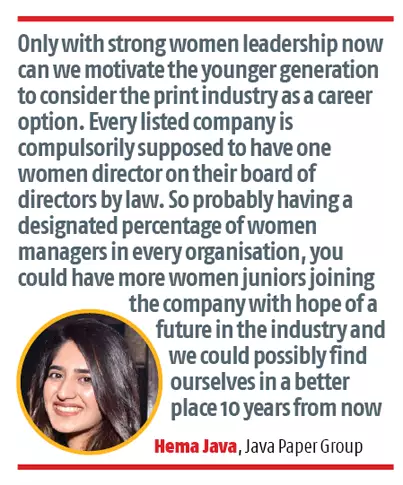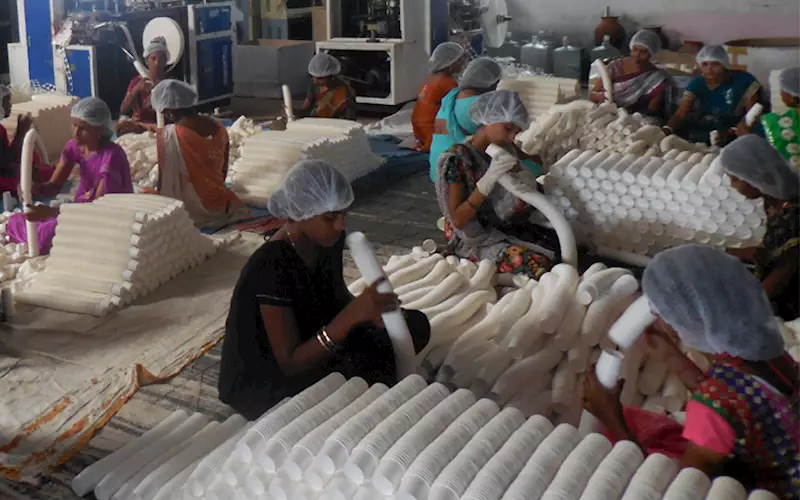Working-women percentage at the lowest. A grave concern - The Noel D'Cunha Sunday Column
Working-women percentage at the lowest. A grave concern
From the ramparts of the Red Fort, India’s Prime Minister stressed on the importance of empowering the women of this country.
Unfortunately, in India women participation in the workforce is generally dismal and the situation in the printing industry seems especially worse.
This Sunday Column, PrintWeek India takes stock of the situation
16 Aug 2018 | By PrintWeek India
Lack of women participation in key roles can be highlighted by the failure of our house of democracy, “Parliament”. The Women’s Reservation Bill to reserve 33% of all seats in Parliament for women was introduced in 1996. It has been 22 years since, and the bill has not seen the light of day to become a law. This begs the question, are we a society that believes in lip service even as we hurtle towards a gender disparity of an unprecedented kind.
According to Print Monthly, a global B2B industry magazine, only one in ten workers in the print industry is a woman.
Reet Arora, director of Bir Hoirzons, Noida, agrees. She says “It must be understood that women power is the ‘half power’ of our nation and combining their power with ‘men’ power can make the country more powerful, and no other country would be stronger than India. Let us give equal opportunity to women.”
Stats say women contribute one-sixth of economic output, among the lowest shares in the world and half the global average. The female employment rate in India including formal as well as informal, has reached 26% from 35% in 2005. An incredible stat is, 25 million women have exited the Indian labour force in the past 10 years. India rate of female labour-force participation in South Asia is the lowest, with the exception of Pakistan. Globally the rate of women participating in the labour force is rising whereas in India it is plummeting.
As per a World Bank report, 90% of Indian women are engaged in household work. If the men spend at least two hours a week in house activities, this would give a boost to women clout in the workforce by a significant 10%.
So let us assess what are the factors that are contributing to this trend...
One good reason is, girls who are literate or semi-literate shun manual labour. According to a report by IndiaSpend, the enrolment rate of girls in elementary education is nearly 100%. In higher education, it’s up from 7.5% in 2002-03 to 20% in 2012-13.
Indirani S of ASA Screens, Hosur, Tamil Nadu, says, “An empowered woman is one who has education, right learning and is capable of self-earning without having to depend on others in the family.”
When I spoke to my print college classmates, they said, when a man seeks a job, he needs no one’s permission. “Girls and women have to combat patriarchy and a plethora of permissions from fathers, brothers, husband – and society.”
Radha Khandelwal, director of Nextgen Printers, Kolkata says, “Striking a balance between home and office is not a problem or an issue once you get to change your mind set. I understand it is difficult for many, especially in the Indian scenario. Once you are able to get the backing from the family, the rest is easy. I am among the fortunate women in India who have the full support of the family.”
Many of my classmates from college are not as fortunate as Radha Khandelwal. They are home-makers. They shared with me, that as the family becomes affluent and were able to afford a moderate lifestyle, women are expected to “stop working and look after the family members.” A women’s primary objective is considered towards the family first and then the work.
Meeta Shah of A&M Enterprises says "For women in our industry the main factor which affects is the incompatibility of work and family duties. There is a stigma against females working outside the home which is evident in our printing industry which is said to be covered 80-85% by the male."
In many cases, limited mobility from the home to the workplace is a major factor. Even with comfortable road and rail connectivity, safe public transport like metros, it is not boosting women employment. Farther the home is from the workplace, lesser the chance of retaining the job.
According to a report in 2012, 84% of Indians believe men have a right to work instead of women when jobs are scarce. Out of the total jobs created since 2005, a meagre 10% have been occupied by women.
It is also believed, schooling was a parental strategy to improve a daughter’s resume on a matrimonial site. This boosts the prospects of a woman in the marriage market rather than the job market.
The scenario in the print-packaging industry
Interestingly, a sizeable proportion of women in the business are employed in the finishing section of print plants – packing, stamping, collating, stitching and dispatching, while many others are involved in the administration, office support, and sales. Very few women are involved in management and marketing, while a miniscule number actually work on the big heavy metal print presses.
Hema Java, marketing executive, Java Paper Group, makes an interesting observation. “I’ve never been to an Indian packaging event which had seen more than 5% of the total participants as women. There is a deficit, especially in senior management.”
She argues that labour laws in the country, though made to protect the interest of the workers, have actually made it a hindrance for employers to take on employees on their payroll.

Java says, “The maternity leave increased from three months to six months is one such example, wherein the paid leave of six months is becoming a liability on employers making them think twice before hiring a woman employee.”
Java makes an important observation about the prevalent gender-bias in the corporate hierarchy. “Our industry has a mix of old-school print firms, new start-ups and next-gen printers all surviving in this ecosystem simultaneously. Due to this, there is a fair bit of acceptance in the industry of working women but the number is way too low as compared to men in the industry. I personally have encountered gender bias a couple of times. I had someone ask me whether I come to work a full day as it’s assumed that I would probably work just a couple of hours.”
"I have observed the gender bias in the labour section of our printing industry. The working strength and pattern definitely affect the women labour with the heavy-duty machines, its mechanism and most important the time factor which involves working till late hours," adds Meeta Shah. "To tackle this gender gap, there should be training institutes for labour in almost all cities for our industry where both men and women can be educated and trained with different printing and finishing machines thus help them perform better with no gender bias."
Madhura Mahajan, head of the department, printing engineering department, PVG’s College of Engineering, Pune stresses on lack of training. Mahajan says, “Women are not encouraged to receive training or exposure to develop skills in any technical area. This lack of exposure to skill-based work cannot be undertaken, thus lowering their participation in the labour force.”
She adds, “I believe safety, training and enhancing skill-based programs can increase women labour force. Women at a higher cadre should be given higher incentives, training opportunities, and tax incentives.”

What are we losing?
If the gender ratio in the workforce becomes even in India, the IMF estimates, the world’s biggest democracy would be 27% richer.
As per 2015 study by the McKinsey Global Institute, if women participated in the economy at par with men, India GDP could rise by up to 60% or USD 2.9 trillion, by 2025. At present, the contribution of Indian women is 17% and the global average is 37%.
Over 75% of the urban women and 50% from the rural areas who are engaged in household work wants to get a job. Rural women feel they lack the necessary skill set.
Meeta Shah, A&M Enterprises
When women come together, amazing things transpire. Women can think differently about her business and take action to become part of a powerful community, sharing to create profound and extraordinary results. The awards won by A&M are the proof of our capabilities and dedication.
Vani Raheja, Ingenious Appliances and Packaging
My creative inclination got me interested in packaging. We started with getting job work done from various places and finally set up our in-house facility when business started growing. Thus, I started Ingenious Appliances and Packaging, eight years ago, with the blessing and encouragement of my parents.
Zalak B Shethia, Tarun Prints Group
I completed my BSc in fashion designing and a graduate diploma in fashion management from London College of Fashion. Being a fashion designer, my job involves designing garments for women’s western wear where screen printing is the most crucial aspect.














 See All
See All